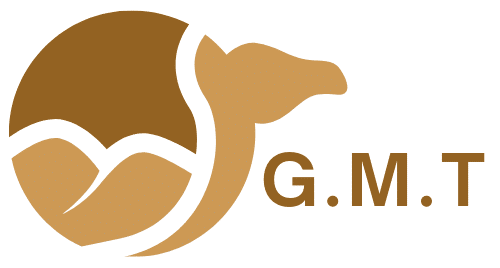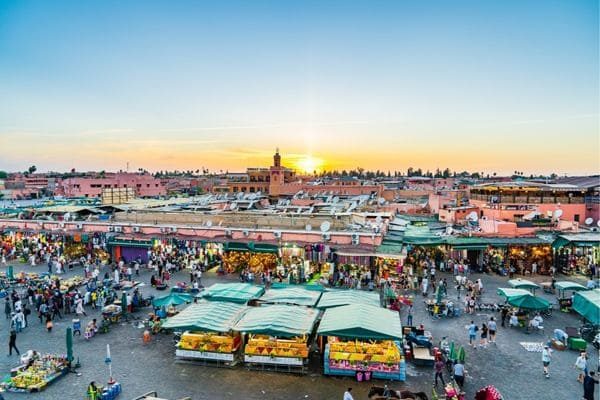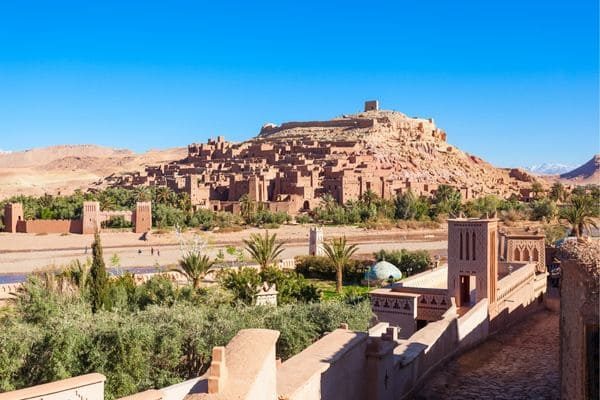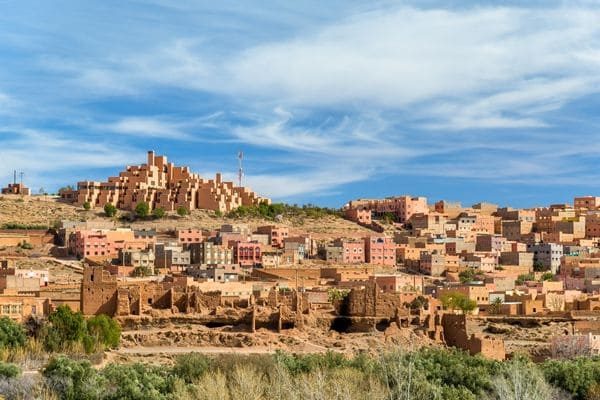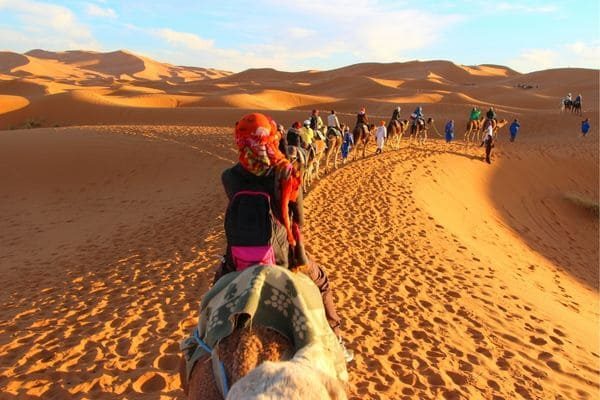4 Days Tour From Marrakech
>> Marrakech To Merzouga Trip 4 Days
Overview:
Our 4 day Trip Marrakech to Merzouga is a great way to discover the beauty of Morocco. This tour takes you from the lively streets of Marrakech to the calm and quiet of the Sahara Desert.
Along the way, you will pass through the High Atlas Mountains, explore ancient villages, visit famous kasbahs, and enjoy the stunning views of Morocco’s landscapes.
You will also get to ride a camel in the Merzouga Desert, sleep under the stars in a traditional Berber camp, and visit some of Morocco’s most beautiful valleys and gorges. This tour offers a perfect mix of adventure, culture, and relaxation.
Highlights:
- Traverse the High Atlas Mountains and Tizi N'tichka pass
- Explore Skoura Oasis and Amridil Kasbah, and Rose valley
- Visit Dades Valley and Todra Gorge
- Overnight in Dades Valley
- Experience a camel ride into the Sahara dunes, enjoying both sunset and sunrise in the desert.
- Sleep under the stars in a desert camp, with traditional Berber music and hospitality.
- Discover the huge desert landscapes, including nomad life, fossil sites, and sand dunes.
- Relax in a desert hotel after exploring the Sahara, join comfort with stunning desert views.
- Discover Draa Valley
- Night in Ouarzazate:
- Visit ouarzazat (home to the Atlas Studios and the impressive Taourirt Kasbah.)
- Spend time within the kasbah of Ait Ben Haddou the UNESCO world heritage site
Informations:
- Place to begin: your riad/hotel in marrakech
- Place to end: your riad/hotel in marrakech
- Period: 4 days/ 3 nights
- Departure time: 8/9 am
THIS IS THE ITINERARY OF THE 4 days tour from marrakech to merzouga:
Day1: Marrakech - ait ben haddou - Ouarzazate - Dades valley
We’ll start our journey early from Marrakech and head towards the High Atlas Mountains. The drive will take us through beautiful mountain roads, and we will stop at the famous Tizi n’Tichka Pass for amazing views of the valleys and peaks.
After enjoying the scenery, we will continue to Ait Benhaddou, an ancient village made of clay that’s been used in many movies. We will have lunch here or in Ouarzazate, depending on the timing.
After lunch, we continue through Skoura, a beautiful oasis filled with palm trees, and stop to visit the Kasbah Amridil a historic fortress in the Skoura oasis, built in the 17th century. It’s known for its mud-brick walls and traditional architecture. You can explore its old rooms and towers, and enjoy views of the surrounding palm trees. It’s a great place to learn about Morocco’s history and culture.
Next, we travel through the Rose Valley, where local women make rose oil and other products from roses. We will stop by a cooperative to learn more. Our day ends in Dades Valley, where we will stay overnight in a traditional riad.
Day 2: Dades gorge – todra gorge – Erfoud - Merzouga
After breakfast, we will explore the Tisdrine Pass in Dades Valley is famous for its snaky road with many sharp turns. From here, you can see beautiful views of the valley and mountains. It’s a great place to stop for photos and enjoy the scenery. Dades Valley and see the famous rock formations called the “Monkey Fingers” because of their unusual shapes. We then continue to the Todra Gorge, a tall and narrow canyon that’s perfect for a walk. The cliffs are impressive, and you’ll feel tiny standing beneath them!
We will stop for lunch in the small town of Tinjdad, where you can also see traditional Berber houses. Afterward, we visit local Berber villages, where you can get a henna tattoo or try on traditional Berber clothes.
We will pass by an old water channel system called “khettarat.” These underground channels were built to bring water from the mountains to the desert areas. Continuing our journey, we stop in Erfoud, a town known for its fossils and date fruits.
Finally, we reach Merzouga, where we ride camels into the Sahara Desert. You will spend the night in a desert camp, enjoying a traditional Berber dinner and sleeping under the stars.
Day 3: Merzouga sahara desert – Rissani – Draa Valley – Ouarzazate
We’ll wake up early to watch the sunrise over the sand dunes. After breakfast at the camp, we leave the desert and visit the nearby town of Rissani, known for its traditional markets and historical importance. It was once a key stop for traders traveling across the Sahara. Today, you can visit its lively market, where locals sell spices, dates, and handmade goods. Rissani is also famous for being the birthplace of the royal family’s ancestors. It’s a great place to experience local life and learn about Morocco’s history.
We’ll then pass through Alnif and make our way to the Draa Valley, one of the largest palm valleys in Morocco, known for its endless rows of date palms and small villages. As we pass through the valley, you will see beautiful views of the green oasis extending along the river. It’s a peaceful and important area for farming and having lunch in Agdez.
In the afternoon, we’ll continue to Ouarzazate, a city known for its film studios and old kasbahs. We will spend the night in a traditional hotel in Ouarzazate.
Day 4: Ouarzazate – Ait Benhaddou – High Atlas Mountains – Marrakech
On our final day, we will visit the famous film studios in Ouarzazate, where many Hollywood movies were filmed. After that, we head back to Ait Ben haddou a famous ancient village made of clay and stone, known for its beautiful kasbahs and traditional streets. This UNESCO World Heritage site has appeared in many movies and gives a great insight into Morocco’s history.
On our way back to Marrakech, we will stop at a local Argan oil cooperative, where you can see how Argan oil is made by hand and learn about its uses. After exploring Argan oil cooperative, we will head back through the Tizi n’Tichka Pass, where we will stop for lunch while enjoying the stunning views of the High Atlas Mountains.
Before we reach Marrakech, We will pass through small Berber villages along the way, arriving in Marrakech in the evening.
- pick up and drop-off at your hotel/riad
- our A/C modern 4x4 or van/minivan.
- drivers/guides speaking English....
- clean vehicle A/C with air condition along the way
- visit some interesting place along the way
- fuel
- first night at private room hotel/riad with "dinner&breakfast"
- sunset camel ride in sahara desert erg chebbi
- second night at private tent on sahara desert erg chebbi camp
- third night at private room in ouarzazate hotel/riad with "dinner&breakfast"
- lunches, drinks
- entrance the monuments
- personal expenses
- local guids in any
KNOW BEFORE YOU GO
- Pack essentials: Bring sunscreen, a hat, comfortable shoes, and warm clothes for the desert nights, especially in winter. Don’t forget a small towel and wet wipes.
- Travel time: The drive from Marrakech to Merzouga is long, about 9-12 hours with stops along the way. Expect beautiful scenery but plan for a full day on the road.
- Accommodations: You will stay in a mix of guesthouses and desert camps. You can choose between standard or luxury camps for a more comfortable experience.
- Camel ride: A camel ride into the desert is included, but you can opt for a 4×4 ride if preferred.
- Meals: Dinner and breakfast are provided at the camps, but lunches and drinks during the tour are not included.
- Local payments: Entrance fees, local guides, and tips are extra costs. Bring cash for these as card payments are not always accepted in remote areas.
- Weather: Desert temperatures can range from very hot during the day to cold at night. Prepare for both extremes.
- Photography: You’ll pass through some UNESCO sites like Ait Benhaddou, so bring a camera to capture the stunning landscapes and historic spots.
Frequently Asked Questions
1.How long is the drive from Marrakech to Merzouga?
It’s about 560 km (348 miles) and takes 9-12 hours, with stops for sightseeing along the way.
2. Can I skip the camel ride?
you can choose to take a 4×4 vehicle to the desert camp instead of riding a camel.
3. What should I pack?
Bring layers of clothing for day and night, comfortable shoes, sunscreen, a hat, and toiletries. Warm clothes are a must for cold desert nights.
4. Are vegetarian or vegan meals available?
vegetarian and vegan meals can be prepared. Just let your guide know in advance.
5. Do I need to carry cash?
Credit cards are not accepted in far areas, especially for things like entrance fees, tips, and drinks.
6. What type of vehicle is used for the tour?
You will travel in a 4×4 or a comfortable van depending on the group size. Both are well suited for long distance desert travel.
7. Is lunch included?
lunch is not included. You will stop at local restaurants for lunch along the way, so plan for extra expenses.
8. Can I customize the tour?
the tour can be customized to suit your needs, from changing the itinerary to selecting different accommodation options.
9. What kind of food is served on the tour?
The meals typically include traditional Moroccan dishes like tagine, couscous, and fresh salads. Breakfast and dinner are served at the guesthouses and camps, and you can request vegetarian or vegan options.
10. Can I charge my phone during the trip?
In the desert camps, there may be limited access to electricity for charging devices. It’s a good idea to bring a portable charger to make sure your phone is charged throughout the tour.
11. Is it safe to travel through the desert?
it is safe. The tour is driven by experienced guides who know the routes well. The vehicles used are well maintained for desert travel, and the camps are safe and tranquil.
12. What happens if the weather is bad?
In case of extreme weather, like sandstorms, the tour might organize the itinerary for safety. However, desert rain is rare, and most trips run smoothly year round.
13. Is sandboarding available?
sandboarding is often available at the desert camps. Just ask your guide, and they can provide you with a sandboard to try out on the dunes.
14. How do I pay for the tour?
Most companies ask for a small deposit when you book, and the remaining balance is usually paid in cash upon arrival. Payment options might change, so it’s good to confirm ahead of time.
15. Can I join a group tour or is it private?
Some tours offer group options, but many are private, giving you more manageable. Group tours can be less expensive, but private tours allow for a more personalized experience.
16. Is Wi-Fi available at the camps?
Wi-Fi might not be available at the desert camps, and if it is, the connection can be slow. It’s a good time to disconnect and enjoy the desert experience.
